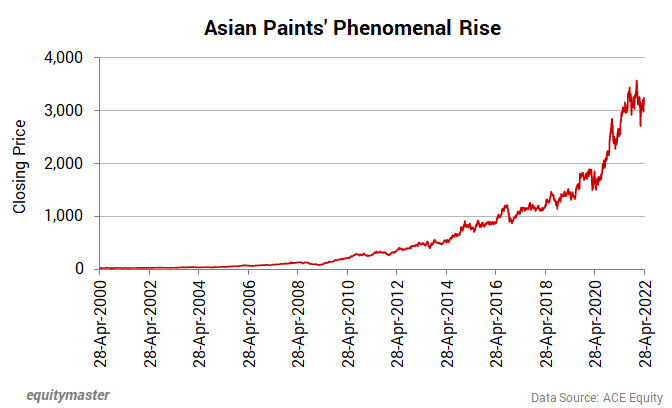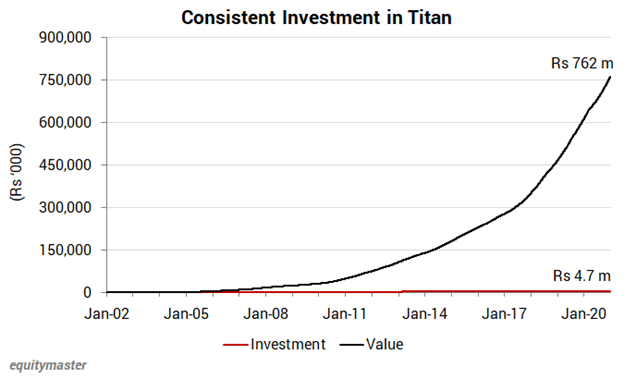- Home
- Views On News
- Apr 29, 2022 - 4 Most Expensive Bluechip Stocks. Should You Sell?
4 Most Expensive Bluechip Stocks. Should You Sell?
What's common between TCS, Asian Paints, Nestle, and HDFC Bank?
They are all bluechip companies.
They are well-established and financially sound companies that could weather turbulent times. They deliver moderate yet consistent returns for their shareholders.
These companies are household names that attract all investors irrespective of their experience with the stock markets.
However, the popularity of such blue chips is the very reason they could tumble sharply.
When naive investors invest in these stocks, they take the valuations a notch higher.
One bad quarter and the stock tumbles like a deck of cards. A classic example is Netflix in the US, which plunged 35% in a day as the company reported a weak quarter.
You read that right. A fall of 35% in one day flat.
Just to put things in perspective, a fall of this magnitude erased all of the company's gains that it had earned since February 2018. That's more than four years' worth of gains decimated in the blink of an eye.
As the market raced up in the last two years, the valuation of bluechip companies also went up.
Will these companies deliver on investors' expectations and make money for them? Or Will they be subjected to similar carnage as was Netflix?
At such heightened valuations, what should be your course of action?. Should you sell and exit? Or should you hold and wait?
Well, in this article, we will discuss the 4 most expensive bluechip companies and whether you should sell them or not.
Let's get started...
#1 Asian Paints
Did you know paint is the only product in India that goes directly from the manufacturer to the dealer? No wholesaler, no distributor in between.
Would you like to guess which company was first to knock off these intermediaries and revolutionise the supply chain?
Drum roll please... It's none other than Asian Paints.
Do you know which company was first to buy a computer and use it for predictive analytics?
Again, it was Asian Paints who did it.
Asian Paints takes credit for many such innovations. It's the largest and the most valuable paint company in India. It's three times more valuable than its nearest competitor, Berger Paints.
And rightfully so. It's one of the consistent compounders in the market delivering mind-blowing returns for its investors.
Just look at the price chart of the company below.

The share price of Asian Paints has grown at a CAGR of 26.6% over the last two decades, doubling investors' money roughly every four years.
1 lakh invested in Asian Paints in 2000 would have been Rs 1.8 crore today.
Feel like you missed the train? Well, you are not alone.
However, shares of Asian Paints have been under pressure of late. The company is down 7.6% year to date.
Why, you ask?
Owing to high crude oil prices, Asian Paints' input cost has increased dramatically, resulting in margin compression. On top of that, the company is trading at a premium valuation to its peers.
Asian Paints is trading at a price to earnings (PE) multiple of 98x. Berger Paints trades at a PE multiple of 84x.
Rich valuations and underperformance don't sound like a good combo, do they?
So, is it time to sell Asian Paints?
If you're worried about the impact of high crude oil prices on the company's financials, let me tell you that the company is not new to facing high crude oil prices.
It has persisted through several bouts of high crude oil prices in the last eight decades while retaining its market leadership. So, the company knows how to survive adversity very well.
Its underperformance could be short-term and the share price could bounce back soon.
Besides, the company's growth prospects are bright.
Asian Paints' product portfolio includes everything that makes a home beautiful. Be it paint, furniture, lighting, etc. Apart from products, it also offers home painting and interior design services.
Simply put, it is an end-to-end home solutions provider.
If the Indian housing market takes off, so will Asian Paints' fortunes.
As per some estimates, India's real estate sector will reach US$1 tn by 2030 on the back of the government's push for affordable housing.
Doesn't that bode well for Asian Paints?
It certainly does.
Thus, if you have invested from a long-term perspective, don't lose your calm over short-term volatility.
Sit tight and let Asian Paints colour your portfolio green.
#2 Hindustan Unilever (HUL)
Think of a brand whose products you use daily, and Hindustan Unilever (HUL) likely owns it.
HUL is India's largest FMCG company, with over 50 brands in its portfolio. The company has a presence across all FMCG categories, such as foods & beverages, personal care, oral care, etc.
HUL strives to dominate a category it operates in. The company markets its brands aggressively to ensure they carve a place in consumers' subconscious. As a result, 9 out of 10 households in India use HUL's one or the other product every day.
Due to its dominant position, HUL's return on capital employed (RoCE) is among the highest in the industry. The company has clocked an average ROCE of 95.9% over the last five years.
The company is a cash chugging machine, which it uses to reward its shareholders in the form of dividends. HUL has paid dividends every year since 1995, barring 2008, when the subprime crisis hit the globe.
Despite all positives, HUL has been in a downtrend since October 2021.
The company reported a weak third quarter owing to high input cost inflation. This triggered a massive selloff from foreign institutional investors (FIIs). FII holding fell from 15.4% in September 2021 to 13.6% in March 2022.
Some analysts attributed HUL's downfall to its rich valuation. HUL trades at a PE multiple of 57.3x
Further, the strike of HUL's distributors in Maharashtra added to investors' woes. The stock may continue to experience some weakness in the near term as Indonesia has banned palm oil exports, a critical raw material used in HUL's products.
However, HUL's long-term outlook is quite strong as India's FMCG industry will reach US$ 220 bn by 2025 from the current value of US$ 110 bn, growing at a CAGR of 14.9%.
So, selling this cash cow could be a mistake.
#3 HDFC Life Insurance
According to the latest economic survey, the penetration of life insurance in India stood at 3.2%. Insurance penetration is the ratio of total premiums to the country's gross domestic product (GDP).
India's life insurance penetration is at par with the global average of 3.3%. While this sounds encouraging, Indian life insurers still have a lot of headroom for growth.
When it comes to life insurance in India, Life Insurance Corporation (LIC) dominates the market with a total market share of 66%.
However, the insurance giant has been losing market share to private players. LIC lost a 6% market share to private insurers over the last six years. Thus, many analysts believe that private insurers are a worthy long-term investment avenue.
As far as private insurers are concerned, HDFC Life is among the top contenders, with a market share of around 10%. It's the most valuable private insurer, commanding a market capitalisation of 1.15 lakh crores.
As far as valuation is concerned, it trades at a PE multiple of 87x. There are a few reasons behind its rich valuation. To begin with, many investors believe the company will grow faster than the overall industry.
Second, the company is part of an esteemed group revered for its rock-solid governing policies.
However, the company has witnessed some weakness in the last few months as it has disappointed investors by reporting weaker than expected numbers.
Analysts attributed weak numbers to the ongoing bull run in the stock markets. They believe insurance products will be back in demand if the market corrects substantially.
Also, many analysts feel that private insurers still haven't won the trust of customers. So, private insurers will have to work a lot on that front.
HDFC Life does command people's trust due to its parentage. The company ensures solid brand recall by employing creative marketing campaigns.
Thus, discarding a leading player in an industry having immense growth potential may not be a good move.
#4 Titan
Do you know which Tata Group company is the most valuable company in terms of market capitalization after TCS?
If you thought of Tata Steel, you are absolutely wrong.
Is your guess Tata Motors? Hard luck.
It's Titan. A diversified bluechip engaged in the business of manufacturing and selling jewellery, watches, and other fashion accessories.
The company's product portfolio caters to everyone's preferences. This is why every business segment of Titan is growing equally well.
Consistency is one of the factors that makes Titan a darling of the investor community. The company's rich valuation is a testament to the investor's love for the stock.
Titan trades at a PE multiple of 100x. What's behind its rich valuation?
Since every business segment is firing equally well for Titan, the company may close the financial year with record revenue.
Being the largest jewellery maker in India, Titan will continue to rake in a fortune due to India's ever-increasing demand for gold jewellery.
High growth prospects and a strong earnings outlook are reasons that make Titan so expensive.
So, should you sell Titan now?
If you wish to benefit from Titan's exponential growth journey, selling it is not an option.
Even a tiny investment of Rs 1,000 per month in the stock of Titan, since 2002, would have led to mouth-watering returns.
Take a look at how the power of compounding has gone wild here...

Also, with the wedding season upon us, Titan is set to benefit. Its revenues are set to increase because demand for gold and gold jewellery will go up.
The precious metal is considered auspicious. It's used extensively to make traditional jewellery. Besides, it's also a popular wedding gift.
Who knows Titan could be the crown jewel of your investment portfolio.
Do bluechip companies deserve the expensive valuation they trade at?
Given their consistency and credibility, bluechip companies deserve a higher valuation than small-cap and mid-cap companies.
Some of these companies that have dominant market share in their respective segments deserve even higher valuation than others due to high earning power.
However, since these companies are well-recognised, even naive investors invest in them taking their valuation a notch higher.
Thus, investors must be very cautious of the price they are willing to pay. If the stock trades at unrealistic valuations, let's say at a PE of 200 or 300, you must stay away from it until it's available at a reasonable valuation.
That's it for this article.
If you like our content, let us know by dropping a comment below.
Until next time...
Happy Investing!
Disclaimer: This article is for information purposes only. It is not a stock recommendation and should not be treated as such. Learn more about our recommendation services here...


Equitymaster requests your view! Post a comment on "4 Most Expensive Bluechip Stocks. Should You Sell?". Click here!
Comments are moderated by Equitymaster, in accordance with the Terms of Use, and may not appear
on this article until they have been reviewed and deemed appropriate for posting.
In the meantime, you may want to share this article with your friends!